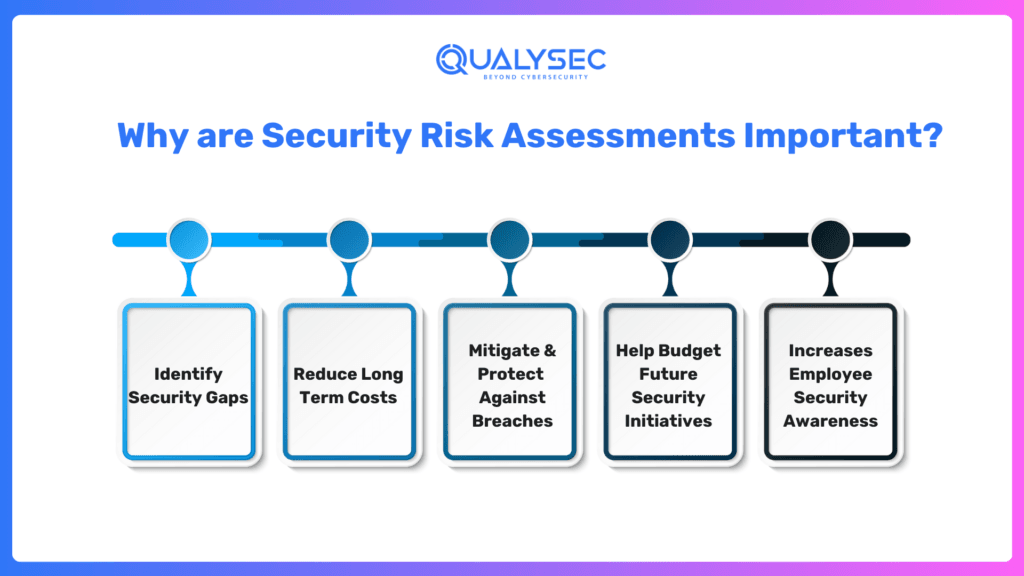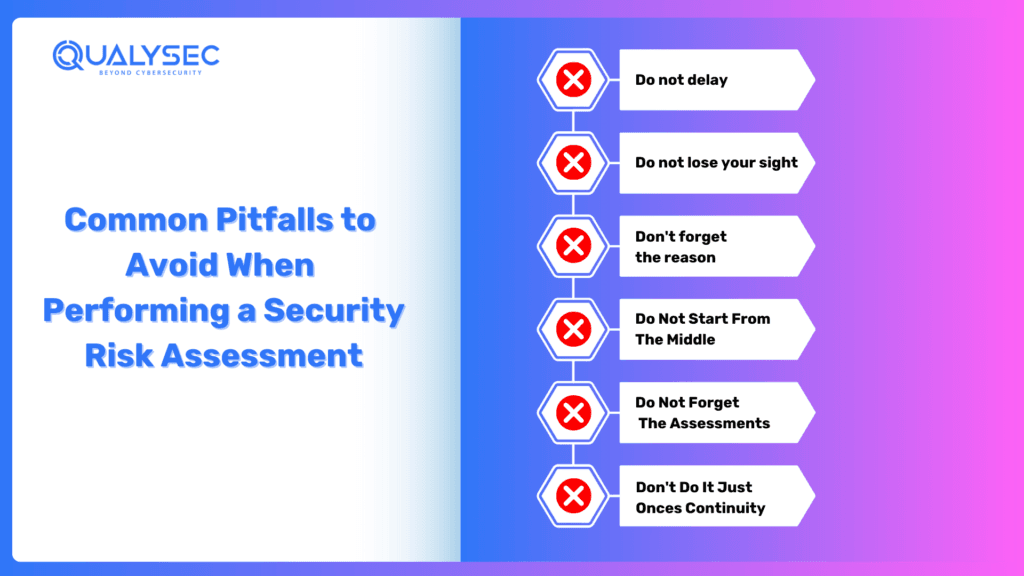A site security risk check finds weak spots in property, people, and assets ‒ helping to reduce harm. This check involves spotting weaknesses, judging threat levels, and making a plan to fix issues. A Security Risk assessment helps keep places safe ‒ whether homes, businesses, or factories. In this blog, we will guide you through key steps for a detailed site security risk check.
What Is a Security Risk Assessment?
A Security risk assessment identifies, evaluates, and ranks all the risks for different information assets (i.e.systems, hardware, applications, and data) and then ranks various risk scenarios that those vulnerabilities may cause.
The results of these risk assessments aim to alert organizational decision-makers of the vulnerabilities in their systems so that they can develop responsive defensive measures as well as effective risk responses.
The assessment also provides a summary for the executive to guide executives in making decisions regarding continuing efforts in security.
Security risk assessment also point to management areas where employees require training to help minimize attack surfaces.
Risk Assessment vs Risk Management
While these concepts appear to be common sense, they are important differences that executives and management should appreciate.
- A risk assessment is a proactive process mainly.
- It scans your current infrastructure and identifies weaknesses and vulnerabilities.
- Risk assessment is the first step or prerequisite for efficient risk management.
- Risk management may be proactive or reactive.
- Risk management is mainly an exercise in diminishing risk through consistent best practices.
- Risk management encompasses infrastructural management and upgrades to implementing identity management policies, down to staff sensitization on the best ways to manage passwords.
- Regrettably, most successful attacks will still occur despite excellent risk assessment and proactive risk management.
- Reactive risk management is about mitigating the damage done by exploits that have managed to be a successful and fast recovery.
Why are Security Risk Assessments Important?

The answer is simple: successful attacks cause massive financial and reputational damage.
23% of small businesses suffered at least one attack in 2020; their average annual financial cost was higher than $25,000.
And the estimate above is still lower than many others.
However, the initial financial costs of dealing with breaches are just one aspect of the damage.
Companies also can experience loss of customers, loss of reputation, loss of intellectual property, and premium insurance, among others.
The cost of cyber security assessment is very low compared to the damage caused by a successful attack. And the benefits associated with it more than offset those costs.
Identify Security Gaps
Numerous organizations just lack awareness of even the simplest parts of cybersecurity ‒ they don’t know what they don’t know.
Risk assessments ‒ e.g., evaluations ‒ discover security holes at all levels, from physical safety to advanced malware spotting and removal.
They also prevent unnecessary spending by focusing on the top security controls and prioritizing security risks.
Reduce Long Term Costs
This goes far beyond comparing the cost of the security risk assessment to the cost of a later breach. Risk assessments also show companies how to prioritize their security spend to minimize long-term costs.
Just take a look at the HIPAA risk analysis chart again.
Many company executives would not think that A/C maintenance is a cyber security risk.
But a $3,000 investment in updating the air conditioner might save the company $10s of thousands down the road.
And the quicker companies act, the more their efforts can pay off.
Mitigate & Protect Against Breaches
The web security assessment report must be action-oriented to be effective.
This means that there must be precise recommendations for remediation activities within the report.
Assessment reports must inform firms on how they can harden their systems to fill security gaps.
It should also be equally critical that reports bring out issues that, at a glance, might appear problematic but are so unlikely to require any action.
Help Budget Future Security Initiatives
Security risk assessments set the baseline for a company’s ongoing cybersecurity efforts.
By prioritizing identified gaps, they help companies create detailed plans for corrective actions.
With detailed plans in place, companies can then set realistic budgets for their IT and cyber security teams.
They can also take rapid steps to address staffing shortages, which can take time, given the current cybersecurity talent gap.
Increases Employee Security Awareness
The employees’ poor security practices create the biggest vulnerabilities for businesses.
The development of a corporate culture based on cyber security awareness is crucial.
Risk assessments point out areas that need training to be provided to employees so as to reduce risk in the future.
Latest Penetration Testing Report

What are the Different Types of Security Risk Assessments?
Comprehensively covers all types of risks, such as location security, infrastructure security, data security, and employees’ potential for misappropriating or damaging data or systems.
Physical Security Assessment
- How hard is it for people to gain physical access to your systems?
- Do you have security at the entrances to the building?
- Do you log visitors?
- Are there security cameras in sensitive locations?
- Do you have biometric locks in your server room?
Physical security assessments, such as penetration testing, will measure how easily a malicious actor can access your critical systems.
IT Security Assessment
What is the state of your IT infrastructure? What network-level security protocols do you have in place? How are you ensuring compliance with shared security responsibilities in cloud services?
IT security assessments investigate the overall health of your IT infrastructure and communications pathways.
They present general system weaknesses that are not application-specific or in terms of the data storage itself and misconfiguration issues that often provide loopholes that lead to companies being attacked.
Data Security Assessment
Is company data under least privilege and/or zero trust access controls?
Do you use network segmentation as a method of access limit for data?
Do you have strong identity management processes?
Data security assessments take into account the simplicity and width of corporate data access.
They identify areas where companies should apply new controls to limit access to data on an as-needed basis.
Application Security Testing
- Do company applications comply with security-by-design and privacy-by-design principles?
- Have you tested your applications using white and black box testing?
- Is access to applications subject to least privilege control?
Application security assessments include vulnerabilities at all levels, from the code itself down to who has access to the applications.
They enable companies to harden their applications and limit access to only that required by employees to perform their jobs.
Insider Threat Assessment
Many, if not most, attacks originate from insider threats. However, many companies do not realize that insider threats go beyond employees who are intentionally trying to steal information or damage systems.
Insider threats are not limited to people. They can include unapproved hardware that is not subject to a BYOD policy. They can also include outdated hardware.
Insider threats cannot be intentional, either. No less damaging may be the fact that negligence may be an equally potent threat that is unintentional.
A common example is changing your password to “password.”
A growing class of insider threats that many business organizations fail to recognize involves the advanced persistent threat (APT).
APTs are long-term, targeted insertions into your network that are often found in the weapons arsenals of state-sponsored cybercriminals or corporate espionage professionals.
Many times, careless or uninformed employees are the attack vectors for an APT. Phishing e-mail are a common method for attackers to get access to a company network.
In other words, the APT remains hidden in company systems for so long that it eventually becomes an insider.
Different types of penetration testing can be applied to assist each security assessment.
What Security Risk Assessment Framework Should You Follow?
To answer this question, you first need to establish your goals for the security assessment.
If you wish to perform a general, overall assessment of your organization’s security posture, then you are looking for one of the more general frameworks, such as the CIS top 18.
CIS top 18 assessments are also beneficial for small and medium businesses and companies with a limited security budget.
More mature or better-funded companies may consider using ISO 27001 or NIST 800-171 as the basis for their security assessment efforts.
If your goal is compliance, then you are more likely to consider industry-specific requirements, such as the HIPAA assessment described above.
And how you move forward with the assessment may depend on where you fall within the groups that HIPAA applies to.
For example, data processors may have security considerations that differ from those of healthcare clearinghouses.
E-commerce firms and other merchants who process electronic transactions may wish to perform risk assessments that focus on their PCI-DSS compliance.
The ability to provide secure payment systems is an important aspect of online business.
Again, your needs will vary depending on whether you are a data holder, a data processor, or both.
Defense contractor or government supplier?
Then, you need to have Cybersecurity Maturity Model Certification (CMMC).
CMMC requirements weren’t all that different from NIST 800-171, with third-party auditing and certification taking the place of self-certification.
Even if your industry has no specified cybersecurity requirements, you ought to consider becoming compliant with one or several of the aforementioned standards.
Common Pitfalls to Avoid When Performing a Security Risk Assessment

In conducting security risk assessments, knowledge about the wrong things that organizations usually do is very important in order to derive maximum benefit from the security risk assessment.
If you understand it, you will easily avoid making these blunders.
Do not delay
Every moment you do not apply adequate controls and remediation measures leaves you open to attacks, breaches, and attendant liability and costs.
Do not lose your sight.
Often, organizations hold the opinion that security risk assessments only include electronic assets and resources. Among physical threats and human threats, it is important not to forget to count.
Don’t forget the reason.
The purpose for which you plan a risk assessment will help to apply labor and monetary resources accordingly on.
It is also cheaper to stay on the straight side instead of performing a broad sweep with no end goal.
Do Not Start From The Middle
Never make an assumption of risks right from the start without properly preparing for remediation. Very critical for remediation is starting from proper inventories and data flows.
Do Not Forget The Assessments
You will need to use tools to conduct assessments and implement remediation plans, but this is not an area where you should push the human factor aside.
Instead, engage both your internal security experts and external providers in order to understand the results the tools generate fully.
Engage your C-suite in order to instill in your enterprise a necessary culture of cybersecurity, which will include training all employees on the basics of cybersecurity, which forms the best base for ongoing security activity.
Don’t Do It Just Once
It will not work if you run a risk assessment once, implement a remediation plan, and then stop.
Threat actors are constantly evolving, and you need to update your assessments continually to keep pace with them.
Talk to our Cybersecurity Expert to discuss your specific needs and how we can help your business.
Conclusion
The security risk assessment is a very crucial step to safeguard and secure the environment. Proper identification of the vulnerability, threat assessment, and taking necessary steps can greatly diminish the risk, protecting the people and assets. Because security assessments are done more frequently, this means you are always up to speed and your security strategy is up to date. The sooner you get it done today, the safer, the compliant, and the less troubled your site will be in future times.































































































































































































































































































































































































































































































































0 Comments